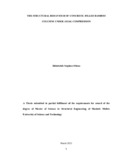| dc.contributor.author | Otieno, Shitabuleh Stephen | |
| dc.date.accessioned | 2021-06-08T07:22:36Z | |
| dc.date.available | 2021-06-08T07:22:36Z | |
| dc.date.issued | 2021-03 | |
| dc.identifier.uri | http://r-library.mmust.ac.ke/123456789/1634 | |
| dc.description.abstract | Bamboo is a renewable and versatile resource, characterized by high strength to weight ratio, and has been widely used in the past to build both permanent and temporary structures. However it has a low compressive bearing capacity with culm buckling considered to be one of its critical mode of failure This limits its application to structures under light loads. This research proposes an innovative scheme to improve the load bearing capacity of bamboo by filling it with concrete to form a concrete –filled bamboo composite (CFB) column. The performance of such columns subjected to axial loads was experimentally investigated with parameters of interest being effect of concrete grade on load carrying capacity, deformation behaviour, confinement effectiveness and stress strain characteristics. Two types of concrete mix C20 and C30 were used to fill bamboo of diameters 55mm, 75mm and 100mm and heights 300mm,200mm and 150 mm for each diameter. Experimental results showed that axial load bearing capacities of bamboo filled with concrete mix C30 and C20 are much higher than the conventional bamboo regardless of the height and diameter of the column. However, bamboo filled with concrete mix C20 exhibited a more ductile behaviour and underwent large deformations before failure than when filled with concrete mix C30. In addition, capacity enhancement and confinement effectiveness were more pronounced in columns filled with concrete mix C20, attributed to low stiffness and flowability of the concrete. Stress strain response was initially linearly elastic upto about 20% of the maximum crushing stresses. Above this point, the stress increased gradually up to the maximum crushing stresses. Upon attaining maximum crushing stress, the curves descended into a softening region and eventually crushing failure occurs at an ultimate strain in tension. Finally, an equation was proposed for predicting the ultimate bearing capacity of concrete-filled bamboo columns. Results calculated from the developed model compared well to those obtained from the experiment with R2 = 0.723 hence can be used in predicting the axial load capacity of concrete-filled bamboo columns. | en_US |
| dc.description.sponsorship | MMUST | en_US |
| dc.language.iso | en | en_US |
| dc.publisher | MMUST | en_US |
| dc.subject | Structural, Behaviour, Concrete, Bamboo, Axial, Compression. | en_US |
| dc.title | THE STRUCTURAL BEHAVIOUR OF CONCRETE- FILLED BAMBOO COLUMNS UNDER AXIAL COMPRESSION | en_US |
| dc.type | Thesis | en_US |

